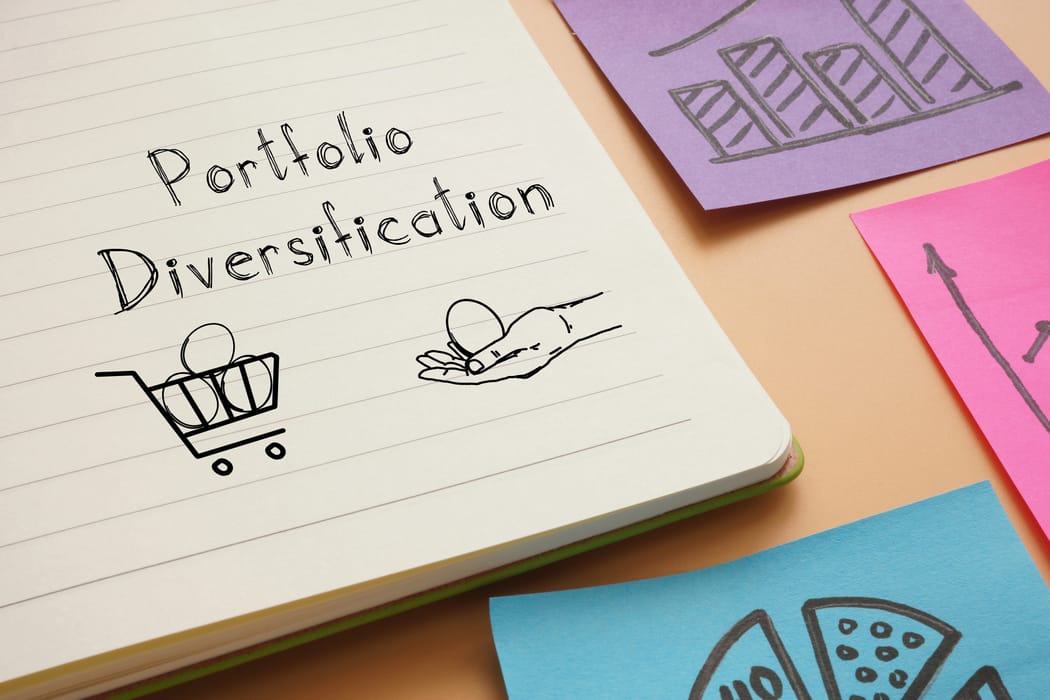This article explores how to diversify portfolio effectively, why it matters, and how investing tools can build stronger, more balanced strategies from day one.
What is portfolio diversification?
Diversification is an important principle for most investment strategies to avoid relying too heavily on any single asset. Instead of putting all your capital into one stock, fund, or market, you spread it across multiple areas and markets. This creates a healthier structure that can respond to different market conditions.
To diversify your portfolio, you combine various elements: asset types, sectors, regions, and even risk levels. For example, one investor might hold EU stocks, government bonds, real estate funds, and a portion of cash. If one area underperforms, others may help reduce the impact. That’s the core idea behind portfolio diversity.
Learning how to diversify portfolio from day one means making choices that support flexibility and control over time. It’s not about finding the “perfect” asset; it’s about building a strategy that can handle the unknowns.
Benefits of diversification
Diversifying your portfolio offers more than just variety — it’s a risk management tool with long-term advantages. Here's how a good portfolio diversification strategy supports stability and growth:
- Reduces investment risks. Markets shift all the time. If you diversify your portfolio across uncorrelated assets, like equities and bonds, poor performance in one area may be balanced by gains in another. This helps limit losses during downturns.
- Balances cost and volatility. High-growth assets often come with high fees or unstable performance. Mixing them with lower-cost or more stable investments spreads the impact. This makes the overall return more predictable without overpaying for risk.
- Improves long-term portfolio stability. Different assets react differently to interest rates, inflation, or market shocks. A diversified structure allows your portfolio to stay functional and adaptable, even when one asset class struggles.
- Smooths your returns over time. Diversification won’t guarantee top gains, but it reduces the chance of major losses. Instead of chasing highs, you aim for steady performance. For most investors, this consistency matters more than extreme results.

How to diversify your portfolio
Diversification starts with structure. You don’t need dozens of accounts or hard-to-manage tools like derivatives, structured notes, hedge funds, or leveraged ETFs. What you need is a mix that aligns with your goals, timeline, and level of comfort with risk.
The examples below are provided for illustration only and do not represent investment advice or recommendations.
Here’s how to make a diversified portfolio using simple, proven steps:
Spread across sectors
How should you diversify your portfolio to manage sector risk? Don’t rely on a single industry. Tech stocks might boom, but healthcare, energy, or consumer goods may perform better during a downturn. A sector mix helps reduce the impact of bad news in any one field.
Let’s say you invest €5,000. Avoid placing it all in tech companies like SAP or ASML. Split it between sectors. For instance, €1,500 in EU healthcare (e.g., Sanofi), €1,000 in consumer goods (e.g., Unilever), and €1,500 in energy (e.g., TotalEnergies). That way, if tech faces a downturn, other sectors may keep your portfolio afloat.
Use different asset types
To diversify your investment portfolio properly, include various assets — equities, bonds, real estate funds, and cash. Each reacts differently to economic changes. For example, stocks may rise with growth, while bonds hold steady during uncertainty.
If you’re holding €10,000, you might place €5,000 in a broad equity ETF (like iShares Core MSCI Europe), €2,500 in eurozone government bonds, €1,500 in a real estate investment trust (REIT), and keep €1,000 in a high-yield savings account. This way, your portfolio doesn’t rely on one asset’s performance — it reacts differently to inflation, interest rates, and market cycles.
Mix regions and currencies
Knowing how to diversify investments includes looking beyond your home country. Holding only local investments can expose you to national risk. By adding assets from other EU countries or global markets, you get access to different growth cycles and reduce dependence on one economy.
Imagine you invest €8,000. Keeping all of it in domestic assets, say, only French companies, ties your success to one economy. Instead, allocate €3,000 to EU-wide funds, €2,000 to Nordic stocks (e.g. Swedish industrials), and €2,000 to global ETFs that include USD- and GBP-denominated assets. This regional mix lowers exposure to local political or economic risks.
Manage asset ratios actively
How you split your capital between asset classes affects your overall return and risk. Someone saving for retirement might choose 60% equities and 40% bonds. Someone closer to retirement might reverse that. This ratio is the foundation of how to diversify your portfolio efficiently.
Suppose you're 35 and saving long-term. You might start with 70% equities and 30% bonds. For example, €7,000 in equity index funds and €3,000 in eurozone bond ETFs. As you approach retirement, gradually shift to 40% equities and 60% bonds to reduce risk. Many platforms let you adjust ratios automatically or offer glide path options to help rebalance over time.
Consider passive tools
If you’re unsure where to begin, funds and ETFs offer an easy way to create a diversified portfolio. Instead of selecting each stock or bond yourself, you buy into a broad bundle, managed and balanced for you.
If you’re just starting out with €2,000, a global multi-asset ETF like Vanguard LifeStrategy 60/40 or Amundi Diversified Growth offers instant diversification. These funds include hundreds of equities and bonds across sectors and countries. All are managed under one product. It’s a low-effort way to create a diversified portfolio without picking each investment manually.

How to keep your portfolio diversified
A diversified portfolio needs maintenance. Markets shift, asset values change, and your life circumstances evolve. That’s why understanding what it means to diversify your portfolio includes not just how you build it but how you maintain and adjust it over time. To keep your portfolio balanced, you need a few simple habits.
Rebalance regularly
Rebalancing is a core part of diversifying an investment portfolio effectively. Over time, different assets in your portfolio will grow at different rates. This can shift your original balance and expose you to more risk than you intended. Regularly adjusting your holdings helps you stay aligned with your goals and maintain the right level of risk.
For example, imagine your original allocation was 60% equities and 40% bonds. After a strong year for stocks, equities might rise to 75% of your portfolio. To correct this, you could sell part of your equity holdings and reinvest in bonds or cash. This brings your portfolio back to its intended structure and prevents overexposure to a single asset class.
Monitor performance and risk
Good portfolio diversification doesn’t mean ignoring what you hold. Review your mix a few times a year to see if it still matches your plan. Ask yourself: how do you diversify your portfolio over time?
Every quarter, set a 15-minute check-in to review your portfolio. Use your broker’s dashboard or a tool like JustETF to see if allocations still match your plan. For example, if you planned for 20% in emerging markets and it’s drifted to 30%, that’s a signal to review. Ask yourself: Is this still aligned with my goals, or do I need to rebalance? Regular review keeps your portfolio intentional, not accidental.
Adapt to changes in life and markets
Your needs will change over time. A portfolio that worked at 30 may not suit you at 60. As your timeline shortens, you may want to reduce risk by shifting more capital into bonds or cash. To diversify your savings effectively, match your strategy to your life stage.
If you're 45 and saving for retirement, your portfolio might lean toward equities. But as you turn 60, you may want to protect capital by shifting more into bond funds or savings accounts. For example, moving from 70% stocks to 50% can reduce volatility. To diversify your savings effectively, align your portfolio with your current priorities, not with decisions made a decade ago.
Avoid over-diversifying
While variety is key, too many small holdings can be hard to manage. Instead, focus on meaningful diversification — not just more assets but the right combination. What is a good diversified portfolio? One that covers major asset classes and regions without becoming cluttered.
Holding 50 small positions might feel safe, but it often leads to overlap and confusion. For example, buying five ETFs that all track large-cap EU stocks doesn’t improve diversification — it just adds redundancy. Instead, aim for coverage across major asset classes with minimal overlap. A good diversified portfolio might include one global equity fund, one bond fund, and one alternative asset — clean, balanced, and easy to manage.
Use tools that support diversification
At Quanloop, we design our investment model to help you diversify your portfolio automatically. You don’t need to select assets one by one or manage complex allocation rules — we handle the distribution for you, based on risk control and exposure limits.
For example, if you invest €1,000, we split it into hundreds of short-term loan units across various partner projects. A portion goes into our lowest-risk segment by default, while the rest is spread between moderate and higher-risk levels, depending on your preferences. This setup prevents overconcentration and helps your money stay balanced, even if one segment underperforms.
Summary: Build once, improve always
Diversification isn’t about chasing perfect timing or picking the best asset. It’s about building a structure that can handle what the market throws at you. A well-maintained portfolio diversity protects against shocks, smooths returns, and gives your money a better chance to grow steadily over time.
Start with the basics: combine different asset types, sectors, and regions. Adjust your asset ratio as your life and goals evolve. Use tools that help simplify the process. If you’re unsure how to best diversify your portfolio, start small and build from there.
Even for cautious investors, there are options. Platforms like Quanloop, for example, allow you to spread your capital across a wide range of microloans with built-in risk control. While not a replacement for a full portfolio, it’s one way to diversify your investments beyond traditional assets.
In the end, the goal isn’t just to avoid loss — it’s to stay in the game. To diversify your investment portfolio is to reduce regret, maintain balance, and make consistent progress, even when markets don’t go your way.
Frequently Asked Questions
What is investment portfolio diversification?
Investment portfolio diversification is the process of spreading out investments among different asset classes, industries, and geographic regions in order to minimize the impact of any one investment on the overall performance of the portfolio.
What is the example of a diversification?
An example of diversification in a portfolio could be an investor allocating a portion of their funds to stocks, and bonds.
Stocks would provide the potential for growth, but also come with a higher level of risk.
Bonds tend to be less risky, but also have lower returns.
Is diversification a good strategy?
Diversification is generally considered a good strategy for managing risk in a portfolio. Diversification can help to smooth out returns over time, as different investments tend to perform well in different market conditions. For example, bonds tend to perform well when stock markets are performing poorly, and vice versa.
Additionally, diversification can help investors to achieve a more appropriate balance of risk and return for their individual needs and goals.
That being said, diversification alone can't guarantee a profit or protect against loss. It's important to keep in mind that past performance of any asset class is not indicative of its future performance.
What are the benefits of diversification?
There are several benefits to diversifying a portfolio:
- Risk reduction
- Smoothing returns
- Achieving a balance of risk and return
- Access to a wider range of opportunities
What diversification strategies exist?
There are several diversification strategies that investors can use:
Asset allocation: This involves spreading investments across different asset classes, such as stocks, bonds, real estate, and cash.
Industry diversification: This involves investing in companies from different industries in order to reduce the risk of being affected by the performance of any one industry.
Geographic diversification: This involves investing in companies from different countries or regions in order to reduce the risk of being affected by political or economic events in any one country or region.
Risk-factor diversification: This is a strategy that aims to diversify the portfolio by investing in assets that are exposed to different risk factors such as interest rate, credit, equity market, and inflation.
Active vs passive diversification: Active diversification involves actively selecting and managing individual investments, while passive diversification involves investing in a broader range of assets through index funds or exchange-traded funds (ETFs).
List of References
- Source: investor.vanguard.com
- Source: investopedia.com
- Source: investopedia.com
- Source: sec.gov
- Source: cdn.morningstar.com.au






